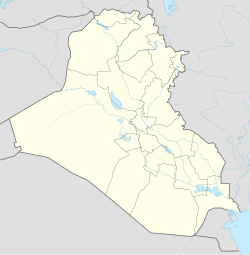Ennigaldi-Nanna's Museum in Mesopotamia
 Archeological excavations at the palace grounds | |
| Established | Circa 530 BCE |
|---|---|
| Dissolved | 5th century-BCE |
| Location | Ancient Ur |
| Coordinates | 30.961667°N 46.105278°E |
| Type | Mesopotamian artifacts |
| Curator | Princess Ennigaldi |
Ennigaldi-Nanna's museum is the earliest known public museum.[1] It dates to circa 530 BCE.[2][3][4][5] The curator was Ennigaldi, the daughter of Nabonidus, the last king of the Neo-Babylonian Empire.[6] It was in the state of Ur, in the modern-day Dhi Qar Governorate of Iraq, roughly 150 metres (490 ft) southeast of the famous Ziggurat of Ur.[7]
Discovery
The museum was discovered in 1925, when archaeologist Leonard Woolley excavated portions of the palace and temple complex at Ur.[5]
He found dozens of artifacts, neatly arranged side by side, whose ages
varied by centuries. He determined that they were actually museum
pieces, because they were accompanied by "museum labels" — clay drums with labels in three different languages, including Sumerian.[which?][5][8][7][9]
History
The palace grounds that included the museum were at the ancient building referred to as E-Gig-Par, which included Ennigaldi's living quarters[10] as well as subsidiary buildings.[5][11][12]
Ennigaldi's father Nabonidus, an antiquarian and antique restorer,[4] is known as the first serious archeologist.[2] He taught her to appreciate ancient artifacts[4] and influenced her to create her educational antiquity museum.[2]
The artifacts came from the southern regions of Mesopotamia.[4] Many had originally been excavated by Nabonidus and were from as early as the 20th century BCE. Some artifacts had been collected previously by Nebuchadnezzar.[12] Some are thought to have been excavated by Ennigaldi herself.[4]
Ennigaldi stored the artifacts in a temple next to the palace where she lived.[4] She used the museum pieces to explain the history of the area and to interpret material aspects of her dynasty's heritage.[8]
Some of these artifacts were:
- A kudurru, Kassite boundary marker (carved with a snake and emblems of various gods).
- Part of a statue of King Shulgi
- A clay cone that had been part of a building at Larsa.[3]
References
- [Encompassed within Iraqi territory is the ancient land of Sumer, which came into being between 6000 and 5000 BC during the Neolithic Ubaid period of Mesopotamian history, and is widely considered the oldest civilization in recorded history. It is also the historic center of the Akkadian, Neo-Sumerian, Babylonian, Neo-Assyrian, and Neo-Babylonian empires, a succession of local ruling dynasties that reigned over Mesopotamia and various other regions of the Ancient Near East during the Bronze and Iron Ages.[1] Iraq during antiquity witnessed some of the world's earliest writing, literature, sciences, mathematics, laws and philosophies; hence its common epithet, the Cradle of Civilization.






Comments
Post a Comment
leave a message please